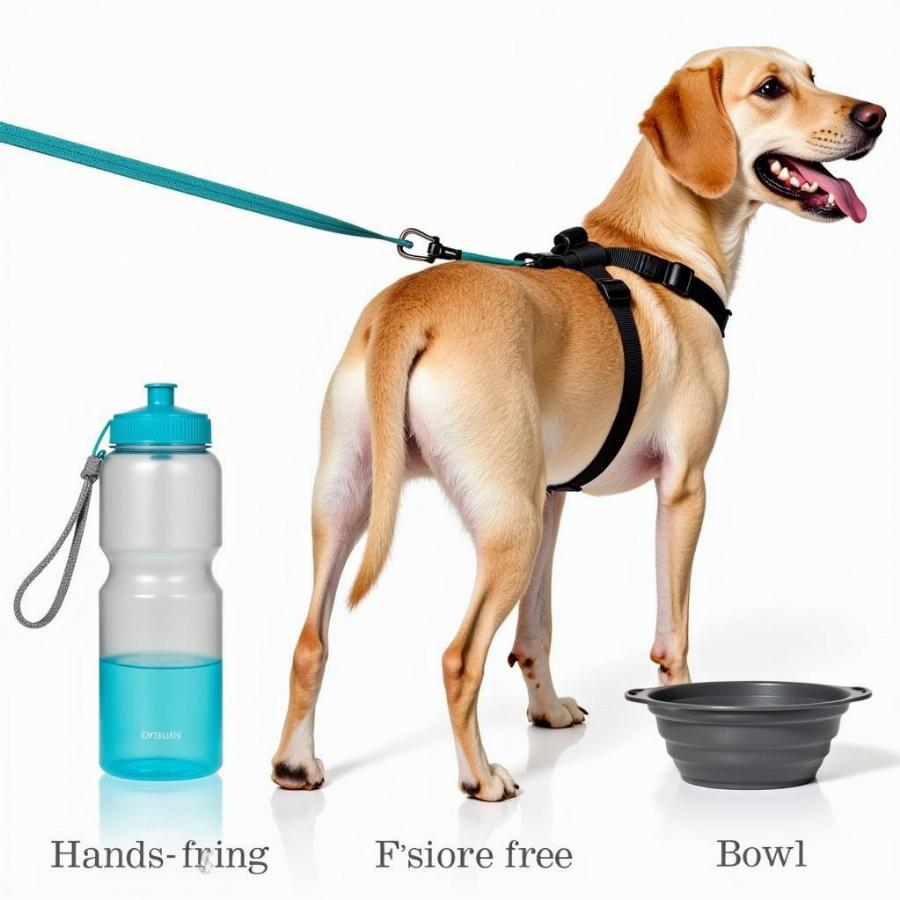Running with your dog can be a fantastic way to bond, stay fit, and enjoy the great outdoors together. But before you grab your leash and hit the pavement, it’s essential to understand how to make running with your furry friend a safe and enjoyable experience for both of you. This guide covers everything you need to know, from choosing the right gear to understanding your dog’s individual needs.
Choosing the Right Dog for Running
Not all dogs are built for running long distances. Some breeds, like Huskies and German Shorthaired Pointers, are natural runners. Others, such as Bulldogs and Pugs, with their brachycephalic (short-nosed) features, are less suited for strenuous exercise. Even within breeds, individual dogs can vary in their fitness levels and enthusiasm for running. Consider your dog’s age, breed, and overall health before embarking on a running routine.
What if your dog isn’t a natural runner? Don’t worry! Shorter, less intense runs can still be beneficial. Always start slow and gradually increase distance and intensity.
Gear Up for Success: Essential Equipment for Running with Your Dog
Having the right gear can make all the difference in your running experience. A comfortable harness designed specifically for running, a hands-free leash, and a water bottle are essential.
What kind of harness should I use?
A running harness distributes pressure evenly across your dog’s chest, preventing strain on their neck and trachea. Avoid using a collar when running, as it can restrict breathing and potentially cause injury. Check out our article on running harness for dogs for detailed recommendations.
What about a leash?
A hands-free leash attached to your waist allows for a more natural running motion and keeps your hands free. Look for a leash that is durable and has a bungee section to absorb shock. A dog leash for runners is a worthwhile investment.
 Essential Running Gear for Dogs
Essential Running Gear for Dogs
Building a Safe and Enjoyable Running Routine
Start with short runs and gradually increase the distance and intensity. Always warm up and cool down with your dog. Monitor your dog’s body language for signs of fatigue, such as excessive panting, lagging behind, or reluctance to continue.
How often should I run with my dog?
Most dogs can enjoy running several times a week. Listen to your dog’s cues and adjust your schedule accordingly. Rest days are important for recovery and injury prevention.
When is the best time to run?
Avoid running during the hottest parts of the day, especially in summer. Early mornings and evenings are usually the best times for running with your dog.
Staying Hydrated on the Run
Just like you, your dog needs to stay hydrated during runs. Carry water and offer it to your dog frequently, especially during longer runs. Collapsible bowls are convenient for carrying water on the go.
How can I tell if my dog is dehydrated?
Signs of dehydration include dry gums, sunken eyes, and lethargy. If you notice these signs, stop running immediately and seek veterinary care.
Running Safety Tips
Always be mindful of your surroundings when running with your dog. Keep your dog on a leash unless you are in a designated off-leash area. Be aware of traffic and other hazards. Carry identification tags for your dog and consider microchipping.
Common Running Injuries in Dogs
Just like human runners, dogs can experience injuries. Common running injuries in dogs include paw pad injuries, sprains, and strains. If your dog shows signs of lameness or pain, consult with a veterinarian.
“Regular veterinary checkups are crucial for identifying potential health issues early on,” says Dr. Emily Carter, a veterinarian specializing in canine sports medicine. “Prevention is always better than cure when it comes to your dog’s health.”
What to Do if Your Dog Gets Injured While Running
If your dog is injured while running, stop immediately and assess the situation. If the injury appears serious, seek veterinary care. “Don’t try to diagnose or treat the injury yourself,” advises Dr. Carter. “A proper diagnosis from a veterinarian is essential for effective treatment.”
Conclusion
Running with your dog can be a rewarding experience for both of you. By following these guidelines, you can ensure that your runs are safe, enjoyable, and beneficial for both you and your furry companion. Remember to listen to your dog’s cues and adjust your running routine as needed. Enjoy the journey together!
FAQ
- Can I run with my puppy? Yes, but keep runs short and low-impact until your puppy’s growth plates have closed.
- What if my dog pulls on the leash while running? Consistent training and a no-pull harness can help.
- Is it okay to run with my dog in the winter? Yes, but take precautions to protect your dog’s paws from ice and salt.
- How can I motivate my dog to run with me? Positive reinforcement with treats and praise can be effective.
- What are some signs that my dog is enjoying the run? A relaxed posture, a wagging tail, and a willingness to keep pace are good indicators.
- What are the best running surfaces for dogs? Grass, dirt trails, and sand are generally easier on a dog’s joints than pavement.
- Should I feed my dog before or after a run? It’s generally best to wait at least an hour after feeding before running.
Further Reading
Check out these related articles for more information: dog running gif, my dogs nose is running, best running dogs.
Beaut Dogs is your go-to resource for all things dog-related. We provide reliable information on dog breeds, care, and much more. When you need expert advice, contact us at [email protected] for detailed and accurate answers. Visit https://beautdogs.com to explore the wonderful world of dogs!